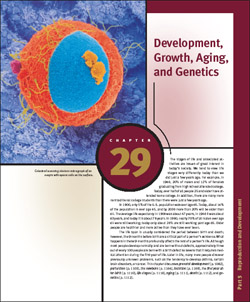
 | The stages of life and associated activities are issues of great interest in today's society. We tend to view life stages very differently today than we did just a few years ago. For example, in 1960, 20% of males and 12% of females graduating from high school attended college. Today, over half of all people 25 and older have attended some college. In addition, there are many more nontraditional college students than there were just a few years ago. In 1900, only 5% of the U.S. population was over age 65. Today, about16% of the population is over age 65, and by 2030 more than 20% will be older than 65. The average life expectancy in 1900 was about 47 years, in 1940 itwas about 63 years, and today it is about 78 years. In 1900, nearly 70% of allmales over age 65 were still working; today only about 20% are still working past age 65. Older people are healthier and more active than they have ever been. The life span is usually considered the period between birth and death; however, the 9 months before birth are a critical part of a person's existence. What happens in these 9 months profoundly affects the rest of a person's life. Although most people develop normally and are born without defects, approximately three out of every 100 people are born with a birth defect so severe that it requires medical attention during the first year of life. Later in life, many more people discover previously unknown problems, such as the tendency to develop asthma, certain brain disorders, or cancer. This chapter discusses prenatal development (p. 1082), parturition (p. 1103), the newborn (p. 1106), lactation (p. 1109), the first year afterbirth (p. 1110), life stages (p. 1110), aging (p. 1111), death (p. 1112), and genetics (p. 1112). |